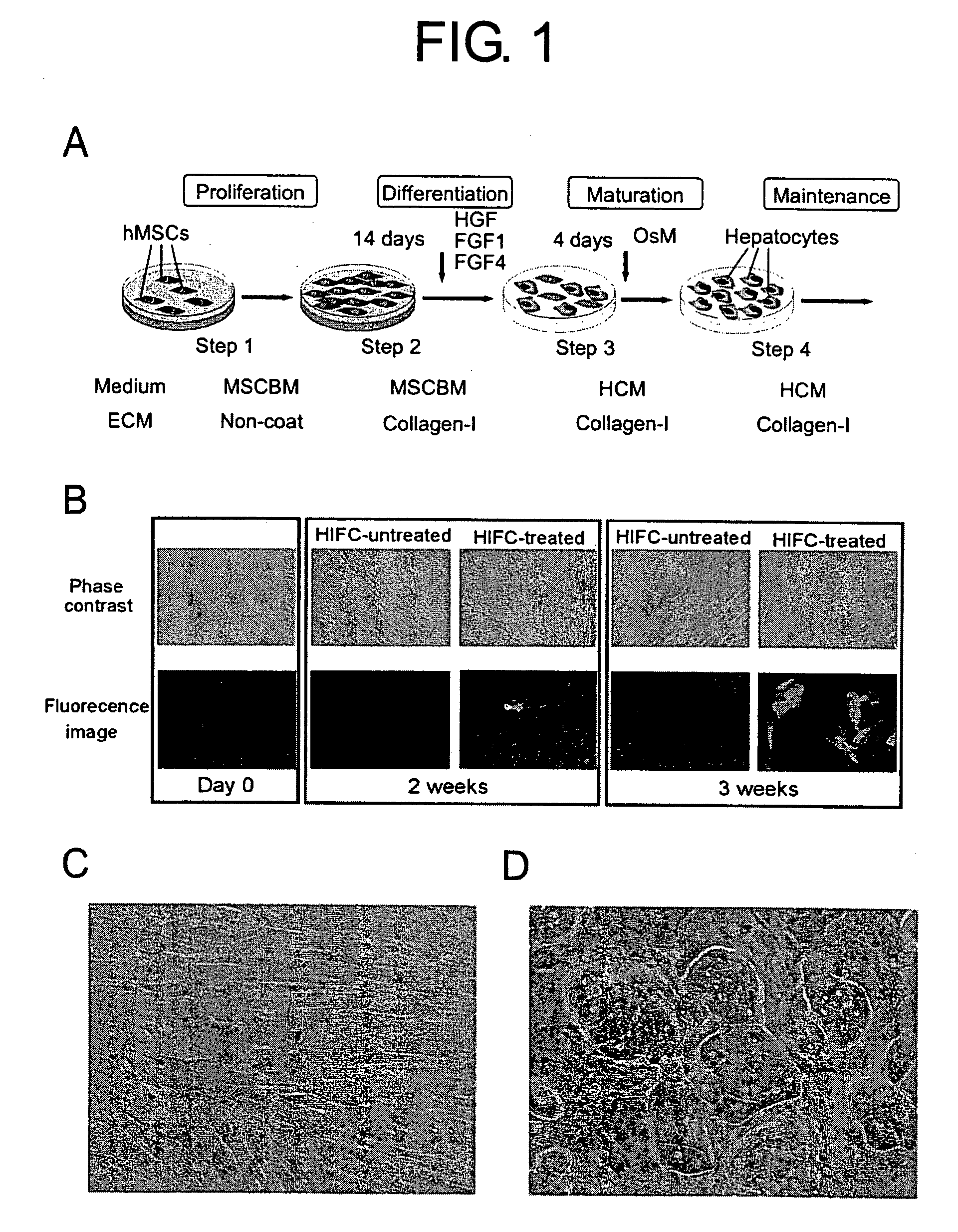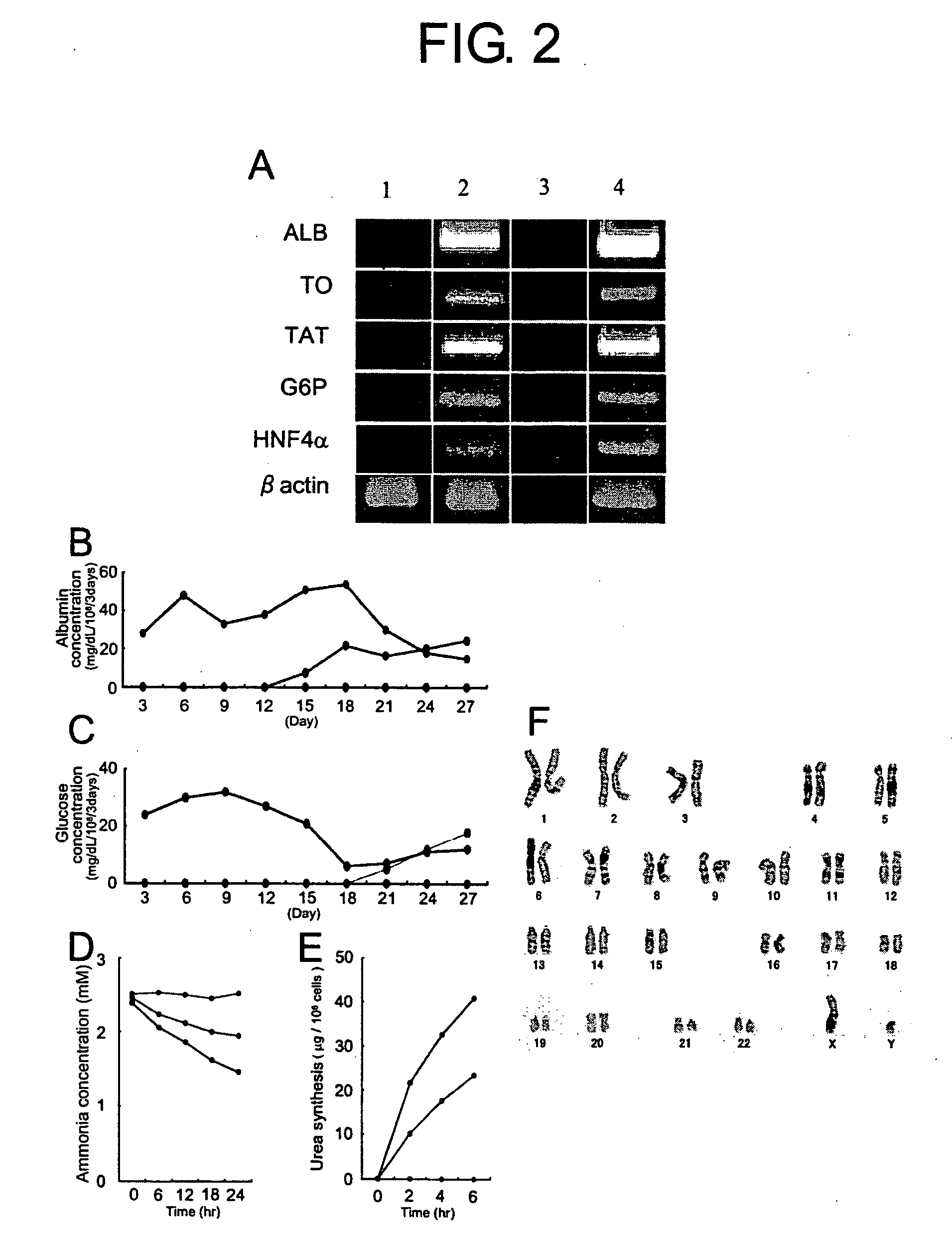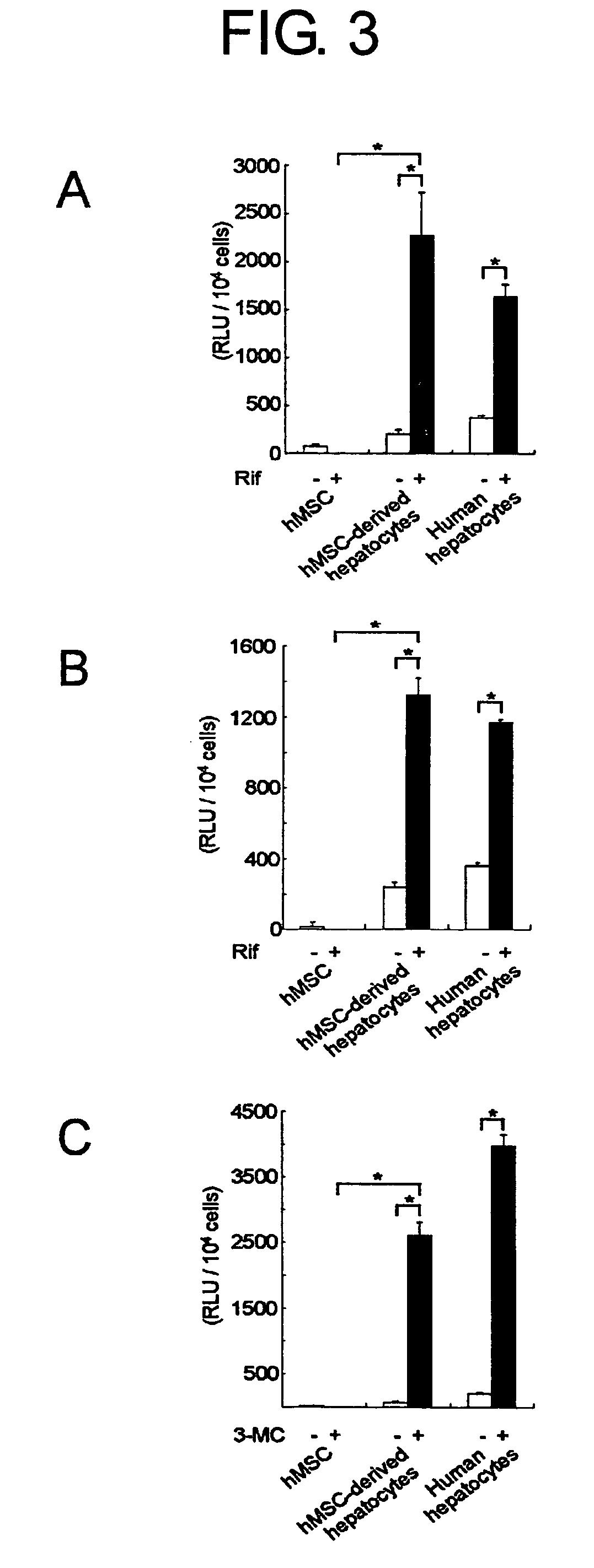Human hepatocyte-like cells and uses thereof
a technology of human hepatocytes and cells, applied in cell culture active agents, artificial cell constructs, instruments, etc., can solve the problems of inability to induce functional hepatocytes by direct differentiation in vitro, and achieve high efficiency
- Summary
- Abstract
- Description
- Claims
- Application Information
AI Technical Summary
Benefits of technology
Problems solved by technology
Method used
Image
Examples
example 1
Culturing Human Mesenchymal Stem Cells and Induction of Their Differentiation
[0113] The human mesenchymal stem cell (hMSC) line was obtained from TaKaRa (Japan) and cultured in DMEM containing 5% fetal bovine serum under 5% CO2 in a humidified atmosphere at 37° C. Specificity of the mouse albumin promoter / enhancer construct (pALB-EGFP) was evaluated by green fluorescent protein (GFP) fluorescence activity (G. Quinn, T. Ochiya, M. Terada, T. Yoshida, Biochem. Biophys. Res. Commun. 276, 1089, 2000; C. H. Sellem, M. Frain, T. Erdos, J. M. Sala-Trapat, Dev. Biol. 102, 51, 1984). For transgene contrast, pALB-EGFP linearized plasmid DNA was used to electroporate hMSCs 48 hr following plating (420 V, 25 μF, pALB-EGFP vector of 50 μg) for co. G418-resistant pALB-EGFP / hMSCs were prepared and cultured on a plastic dish with mesenchymal stem cell basal medium (MSCGM, adding 10% fetal bovine serum).
[0114] To induce maximum differentiation of hepatocytes from hMSCs, the following four steps w...
example 2
RT-PCR Analysis
[0122] To clarify the characteristic features of the GFP-positive cells, the present inventors analyzed the gene expression of a variety of hepatocyte markers and liver-enriched transcription factor by RT-PCR analysis (FIG. 2A).
[0123] At first an aliquot of total RNA isolated from undifferentiated ES cells and GFP-positive cells using ISOGEN solution (Nippon Gene, Tokyo, Japan) was treated with DNase I (amplification grade; TaKaRa, Kyoto, Japan) according to the manufacturer's guidelines.
[0124] RT-PCR reactions were performed using a One-Step RT-PCR kit (QIAGEN, Tokyo, Japan).
[0125] Expression of albumin (ALB), the most abundant protein synthesized by mature hepatocytes, starts in early fetal hepatocytes (E12) and reaches a maximal level in adult hepatocytes (C. J. Pan, J. K. Lei, H. Chen, J. M. Ward, J. Y. Chou, Arch. Biochem. Biophys. 358, 17, 1998). Glucose-6-phoshatase (G6P), tyrosine aminotransferase (TAT) and tryptophan 2,3-dioxygenase (TO) are definitive e...
example 3
Biochemical Analyses
[0127] To further elucidate whether GFP-positive cells display hepatocyte-specific functions, biochemical analyses were performed.
[0128] One day after plating at 2×105 cells / 60-mm dish, GFP-positive hepatocytes or control ES cells and normal mouse hepatocytyes were analyzed for glucose levels in the culture supernatant by the glucose oxidase method, as described previously (H. Yamamoto et al., Hepatology 37, 983, 2003; FIG. 2C). To examine the cellular activity of ammonia detoxification, GFP-positive cells or control ES cells and normal mouse hepatocytes were cultured at 2×105 cells / 60-mm dish in 1.0 ml of DMEM containing 2.5 mM NH4Cl and further incubated for 24 hours. The culture media were tested for concentrations of NH4Cl at 0, 6, 12 and 24 hours by Ammonia-Test Wako (Wako Pure Chemicals, Tokyo, Japan) (FIG. 2D). To assay the urea synthesis ability, cells were cultured with HBSS in the presence of 5 mmol / L NH4Cl. The medium was harvested after incubation ...
PUM
 Login to View More
Login to View More Abstract
Description
Claims
Application Information
 Login to View More
Login to View More - R&D
- Intellectual Property
- Life Sciences
- Materials
- Tech Scout
- Unparalleled Data Quality
- Higher Quality Content
- 60% Fewer Hallucinations
Browse by: Latest US Patents, China's latest patents, Technical Efficacy Thesaurus, Application Domain, Technology Topic, Popular Technical Reports.
© 2025 PatSnap. All rights reserved.Legal|Privacy policy|Modern Slavery Act Transparency Statement|Sitemap|About US| Contact US: help@patsnap.com



